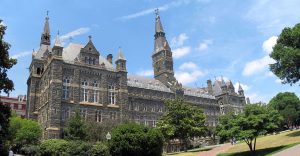Each August, the Voice begins the year with a letter to the student body, especially directed at the incoming class, offering advice on how to best conquer the trials and tribulations of a new school year. Chances are you may be feeling some combination of overwhelmed, stressed, and excited. These, on top of anxiety, fear, or a sense of isolation are entirely normal. Whatever you’re feeling, welcome to the Hilltop! To the freshmen and transfers taking their first steps at Georgetown this fall, we’re happy to have you here. To old faces, we’re happy to have you back.
For many of you, life at Georgetown will change not only your surroundings but also complicate various aspects of your identity. For one, Georgetown’s reputation as a high-achieving institution may cast doubts on your self-worth. You may have previously oriented yourself around grades or extracurriculars. While you may feel the urge to continue doing so at Georgetown, this may be less manageable or fulfilling than before in large part due to the notoriously rigorous club culture. Not only can this culture be frustrating and disheartening, but its orientation towards upward social and economic mobility can mirror systems that afford uneven opportunities to more privileged groups, namely white students and higher-income students who are often in charge of these organizations to start with.
More often than not, however, the metrics by which you define yourself will shift as your role in our community grows and changes—a process that you have control over now, probably more than ever. As you embark on this journey of self-discovery amid new classes and competitive clubs, remember that conventional sources of external validation are by no means the only nor the most important means of cultivating your sense of self. Although it is often stated, it bears repeating that you are far more than your grades and your extracurriculars.
There are many ways to find a meaningful sense of community at Georgetown that go beyond pursuing prestige and clout. In our opinion, this pursuit should at least partly involve reckoning with Georgetown’s problematic history, and subsequently demanding a more just and inclusive Georgetown for all Hoyas. As reiterated in our past welcome-back letters and other editorials, our history is fundamentally grounded in settler colonialism and slavery. Any attempt to distill Georgetown’s historical transgressions into a single editorial wouldn’t even come close to painting a complete picture; instead, take the time to peruse the resources that we have compiled online at the end of this editorial as a starting point.
Even though we only get to call ourselves Hoyas because of these ongoing injustices, we are also afforded the opportunity to help rectify them. Some incredible on-campus organizations are already doing this work and have been for decades. These movements are intersectional, driven, and, though we might not initially realize it, creative. They do not merely react to an exclusionary past but also dare to imagine what an inclusive future could look like outside oppressive frameworks. And as inspiring as their goals are, they are not only mechanisms to fight against injustice—these movements are also spaces to build solidarity and be in community. Activism is, at its core, taking care of one another.
On that note, we encourage you to seek out activities that spark joy for yourself and others. Get involved in some of the many activist movements on campus, as well as other clubs that simply make you happy; despite the general campus culture, many groups here have low to nonexistent barriers to entry. Some of these are affinity groups, like the South Asian Society, the Caribbean Culture Circle, and the Disability Cultural Initiative, to name a few. As affinity groups, they are geared toward unifying communities of students and providing support networks to allow them, no matter their background, to flourish on campus. Other programs like ESCAPE, the first-year retreat, do wonders to foster a sense of community and engage with those around you as fellow students and friends.
These organizations and programs exemplify what is so wonderful about college. They present you with the opportunity to explore interests you might not have had the ability or autonomy to discover before. With this newfound freedom, we urge you to reconceptualize your priorities and dive into activities you’ve always hoped to try. We realize the transition into college can often be jarring, but immersing yourself in community can be a means of prioritizing yourself and your well-being; they can offer both excitement and a slice of something familiar as you settle into a new home.
And as cheesy as it sounds, there is no understating how important it is to say yes to things, even if it might initially feel outside of your comfort zone! Go out; say yes when your new friend from class invites you to get a meal; go to that event you’ve been hearing about but keep finding reasons not to attend. Relish in the unfamiliar and explore new opportunities. They might surprise you. It can be nerve-wracking to dive into the unknown, but we urge you to take that in stride.
To the upperclassmen who have likely heard some or all of this advice before, we invite you to consider it once again. The beginning of the year is the perfect time to view campus through fresh eyes; if we are not reimagining Georgetown every year, we are holding it back from becoming a better place for the people who come after us. It can be easy to grow used to the way things are and remain stagnant, but don’t forget: in everything we do, we form the foundation that future students will use to imagine and enact change. Let’s make it the best it can be.
Even among challenges that may sometimes feel insurmountable, there are exciting and creative things to do, places to see, and people to meet. So when—not if—you take the Hilltop by storm, we hope you will step into your responsibilities with enthusiasm and leave Georgetown having made a positive difference for the school and yourself.
Much love,
The Voice Editorial Board
*****
As mentioned, Georgetown was built on land that was stolen from the Indigenous Piscataway and Nacotchtank. Furthermore, many of the early Jesuits enslaved people. Notably, in 1838, Georgetown notoriously sold over 314 enslaved people, now known as the GU272+, in order to keep itself financially afloat. Read our three-part editorial about Georgetown’s history of racial transgressions, dating back to Georgetown’s complicity in slavery, here: Tear down your monuments to enslavement, Georgetown, Georgetown’s reluctance to teach its history of racial transgression undermines commitment to anti-racism, and Georgetown’s reluctance to teach its history of racial transgression undermines commitment to anti-racism. Hoyas Advocating for Slavery Accountability (HASA), a group of students working with descendents of the GU272+, has been organizing for Georgetown to invest in descendent communities, such as through making reparations.
Just last year, Georgetown University Protects Racists, a coalition of students demanding justice and accountability from Georgetown in the aftermath of a racist hate crime, launched weeks of sit-ins outside the President’s Office. Because of the hundreds of students who showed up, Georgetown committed to working towards its demands. Even years prior, the Black Survivors Coalition advocated for Georgetown to expand on-campus sexual assault resources for survivors, especially Black, femme, and non-binary survivors.
In regard to labor justice, the Georgetown Coalition for Workers’ Rights, a coalition of students and staff in solidarity with campus workers, has been pushing for more rights for decades. As an integral part of our campus, workers have faced challenges like overworking and understaffing—challenges that were exacerbated by the pandemic. Georgetown Alliance for Graduate Employees, the labor union for graduate student employees, has also been bargaining for living wages.
Interested in progressive politics? Georgetown College Democrats and Young Democratic Socialists of America are great places to organize. Some other organizations with adjacent causes include H*yas for Choice, which has organized for reproductive justice such as through calling for the reform of the annual Cardinal O’Connor Conference on Life, the largest collegiate anti-abortion conference in the US, that is held in Georgetown.
Following organizations like Hoyas for Immigrant Rights, No Lost Generation, Georgetown’s chapters of Students for Justice in Palestine and Jewish Voice for Peace, and March for Our Lives on their social media platforms can keep you informed on any opportunities to participate in campus activism and meet like-minded student organizers. The Center for Social Justice is another invaluable resource if you’re looking to volunteer on a range of causes in the broader D.C. community.
Want to escape the Georgetown bubble? Read the Voice’s guide on D.C. museums and affordable eats. To stay in touch with local happenings, read the Washington City Paper and Street Sense Media, the latter of which focuses on issues of homelessness and poverty in D.C. As Georgetown students living in D.C., we ought to engage with issues beyond our front gates. Read our editorial on why D.C. statehood is critical to economic, racial, and criminal justice.





